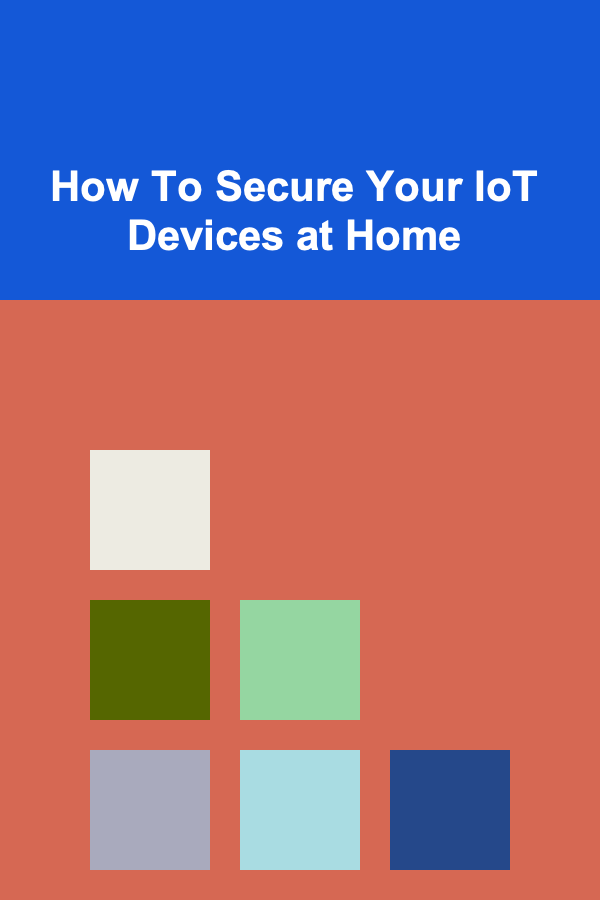
How To Secure Your IoT Devices at Home
ebook include PDF & Audio bundle (Micro Guide)
$12.99$10.99
Limited Time Offer! Order within the next:

In the modern age, the Internet of Things (IoT) has become an integral part of daily life. From smart thermostats to voice assistants and security cameras, IoT devices promise to enhance convenience, improve efficiency, and transform how we live. However, this growing connectivity comes with potential risks to privacy, security, and even safety. As more devices in our homes become interconnected, the importance of securing these devices has never been greater.
This article explores how to secure your IoT devices at home, covering the risks, strategies for protection, and best practices to ensure that your smart home is safe from cyber threats.
Understanding IoT and Its Risks
IoT refers to the network of devices that connect to the internet and communicate with each other, often without direct human intervention. This can include anything from smart refrigerators and doorbells to wearable fitness trackers and security systems. While these devices make life more convenient, they also create new entry points for hackers and malicious actors to exploit.
Common Security Risks in IoT Devices
- Lack of Encryption: Many IoT devices transmit data without proper encryption, leaving sensitive information vulnerable to interception. If your device isn't encrypting data, it can be accessed by anyone on the same network or even through public internet connections.
- Weak Passwords: Many IoT devices come with default passwords that are easily guessable. Devices with weak or unchanged passwords provide an easy target for attackers.
- Unpatched Vulnerabilities: Some IoT manufacturers may not provide regular software updates, or users may fail to install them. These unpatched vulnerabilities can be exploited by cybercriminals to gain unauthorized access to your devices.
- Insecure Communication Protocols: Some devices rely on outdated or insecure communication protocols, which makes it easier for attackers to intercept or tamper with the data being transmitted.
- Physical Access: IoT devices are often physically accessible in homes, meaning that if a malicious actor gains access to your property, they may be able to tamper with or steal devices to exploit them.
- Botnets: IoT devices are often hijacked by cybercriminals to form botnets---large networks of compromised devices that can be used for malicious activities, such as launching distributed denial-of-service (DDoS) attacks.
With these risks in mind, it's clear that securing IoT devices requires a proactive and layered approach to cybersecurity.
Steps to Secure Your IoT Devices at Home
1. Change Default Passwords Immediately
The first step in securing your IoT devices is to change the default password provided by the manufacturer. Many devices come with weak or easily guessable passwords like "admin" or "12345". Changing the password to a strong, unique one is crucial in preventing unauthorized access.
A strong password typically includes:
- At least 12 characters
- A mix of upper and lowercase letters
- Numbers and special characters
- Avoiding easily guessable phrases like your name, birthdate, or common words
Additionally, consider using a password manager to generate and store complex passwords for each device.
2. Enable Two-Factor Authentication (2FA)
Many modern IoT devices and platforms support two-factor authentication (2FA), which adds an extra layer of security. With 2FA, even if an attacker manages to obtain your password, they would still need a second form of verification (like a code sent to your phone) to access the device.
Always enable 2FA on devices and accounts that support it, especially for those that store or control sensitive information, such as security cameras, smart locks, and voice assistants.
3. Update Device Firmware Regularly
Manufacturers frequently release updates to fix vulnerabilities in their devices. However, many users fail to install these updates in a timely manner, leaving their devices open to exploitation.
To stay protected, make it a habit to check for firmware updates regularly. Many devices allow for automatic updates, which should be enabled if possible. If not, ensure that you manually check the device's settings for new updates.
4. Secure Your Home Network
Your home network is the backbone of all connected devices in your IoT ecosystem, and a compromised network can put every device at risk. Here are steps to ensure your network is secure:
- Change the default router password: Just like IoT devices, routers come with default passwords that are often weak. Change it immediately to something more secure.
- Use a strong Wi-Fi password: Ensure that your Wi-Fi network is protected by a strong password using WPA3 encryption (the latest and most secure Wi-Fi encryption standard). Avoid using outdated protocols like WEP.
- Create a guest network: Many routers allow you to set up a separate guest network. This is especially useful for visitors or IoT devices that don't need full access to your main network. Keep your primary devices on a separate network to minimize exposure.
- Disable remote management: Many routers come with remote management features, which allow access to your router from outside your home. Unless you need this feature, disable it to reduce the risk of an external attack.
5. Monitor Your IoT Devices
Regularly monitoring the devices on your network can help you identify any unusual activity. Several security tools and apps can scan your network for connected devices and alert you if any new or unknown devices join the network.
By keeping track of all the devices connected to your home network, you can quickly identify if a device has been compromised or is behaving suspiciously.
6. Use a Virtual Private Network (VPN)
For an added layer of protection, consider using a Virtual Private Network (VPN) on your router. A VPN encrypts all internet traffic coming from your home network, including IoT devices, ensuring that any data transmitted over the internet is secure. This is particularly useful for preventing data interception and protecting your privacy.
Additionally, a VPN can help block access to malicious websites or prevent tracking by third parties.
7. Limit the Amount of Data Shared by IoT Devices
Many IoT devices collect data that is shared with manufacturers or third parties. While this data is often used to improve the device or provide personalized services, it can also be a privacy concern.
To mitigate the risks, review the privacy settings of each device and minimize the amount of data it collects or shares. For example:
- Turn off voice recording or data sharing on voice assistants unless absolutely necessary.
- Disable unnecessary location tracking on devices like smart home cameras or wearable devices.
- Choose devices that allow you to control the data they collect and limit third-party access.
8. Isolate Critical Devices
Some IoT devices, like smart locks and security cameras, control critical aspects of your home's safety and privacy. For these devices, consider isolating them on a separate, more secure network that is not accessible by other less secure IoT devices.
This way, even if one device is compromised, it won't lead to the breach of more sensitive devices.
9. Disconnect Unused Devices
If you have IoT devices that you're not actively using, it's a good idea to disconnect them from your network. Devices that are powered on and connected to the internet can be exploited by cybercriminals, especially if they are outdated or have security vulnerabilities.
Unplugging or turning off unused devices can minimize your exposure and reduce the risk of attacks.
10. Review the Device Manufacturer's Security Practices
Before purchasing any IoT device, it's important to consider the manufacturer's track record on security. Some companies are more committed to providing security updates and protecting user data than others.
Research the manufacturer's reputation and ensure they provide regular firmware updates, have a clear privacy policy, and are transparent about the security of their devices.
Conclusion
As IoT devices continue to proliferate in our homes, ensuring their security becomes an essential aspect of protecting your privacy, data, and safety. By following the steps outlined above, such as changing default passwords, enabling two-factor authentication, updating firmware, securing your network, and using a VPN, you can significantly reduce the risk of cyber threats and enjoy the convenience of a smart home with peace of mind.
As the world becomes increasingly connected, staying vigilant and proactive about IoT security will be essential in safeguarding your home and personal information from potential cyberattacks. By taking these precautions, you can ensure that your IoT devices work for you and not against you.

How to Create a Functional Mudroom During Your Home Renovation
Read More
How to Soundproof a Room with Minimal Construction
Read More
How to Stage a Home During Different Seasons for Maximum Impact
Read More
How to Use Print-on-Demand Services to Make Money
Read More
How to Choose Healthy Convenience Foods for Weight Loss
Read More
Identifying Birds by Their Calls in the Field: A Comprehensive Guide
Read MoreOther Products

How to Create a Functional Mudroom During Your Home Renovation
Read More
How to Soundproof a Room with Minimal Construction
Read More
How to Stage a Home During Different Seasons for Maximum Impact
Read More
How to Use Print-on-Demand Services to Make Money
Read More
How to Choose Healthy Convenience Foods for Weight Loss
Read More